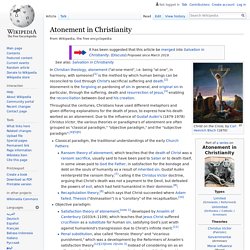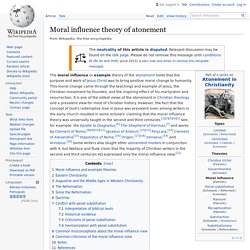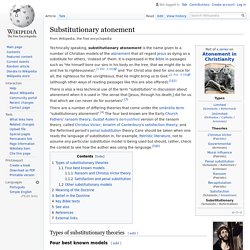

LP4 Atonement. 4B Theories of Atonement. Atonement. Atonement Part B questions. Animated Explanation of Sacrifice and Atonement. Bishop Barron on the Scandalous Cross of Jesus. Why Did Jesus Have to Die the Way He Did? Tom Wright THE ATONEMENT DEBATE. NT Wright: Christus victor vs penal substitution atonement // Premier Christianity. Atonement in Christianity. Throughout the centuries, Christians have used different metaphors and given differing explanations for the death of Jesus, to express how his death worked as an atonement.

Due to the influence of Gustaf Aulèn's (1879-1978) Christus Victor, the various theories or paradigma's of atonement are often grouped as "classical paradigm," "objective paradigm," and the "subjective paradigm":[6] Tracing Atonement Through the Story of Scripture - N.T. Wright Online.
Atonement is one of those complex and tricky words in our Christian vocabulary.

It is easy to assume we all know what we mean when we use it. It’s theological shorthand for how sins are dealt with. But as Professor Wright warns in The Day the Revolution Began, “It is easy to imagine that it carries a single and obvious meaning. It does not.” Often we don’t agree on the meaning of it. It is easy to imagine that atonement carries a single and obvious meaning. Satisfaction Penal Substitution Model. Moral Example. Christus Victor. ‘My God, My God’: When Jesus felt abandoned. When it was noon, darkness came over the whole land until three in the afternoon.

At three o’clock Jesus cried out with a loud voice, “Eloi, Eloi, lema sabachthani?” Which means, “My God, my God, why have you forsaken me?” Mk 15:33–34 Eloi, Eloi, lema sabachthani? Moral influence theory of atonement - Wikipedia. The moral influence or example theory of the atonement holds that the purpose and work of Jesus Christ was to bring positive moral change to humanity.

This moral change came through the teachings and example of Jesus, the Christian movement he founded, and the inspiring effect of his martyrdom and resurrection. It is one of the oldest views of the atonement in Christian theology and a prevalent view for most of Christian history. Moral influence and example theories[edit] A number of theologians see "example" (or "exemplar") theories of the atonement as variations of the moral influence theory.[22] Wayne Grudem, however, argues that "Whereas the moral influence theory says that Christ's death teaches us how much God loves us, the example theory says that Christ's death teaches us how we should live.
Eastern Christianity[edit] Substitutionary atonement - Wikipedia. El Greco's Jesus Carrying the Cross, 1580.

Technically speaking, substitutionary atonement is the name given to a number of Christian models of the atonement that all regard Jesus as dying as a substitute for others, 'instead of' them. It is expressed in the Bible in passages such as "He himself bore our sins in his body on the tree, that we might die to sin and live to righteousness",[1 Pet. 2:24] and "For Christ also died for sins once for all, the righteous for the unrighteous, that he might bring us to God. "[1 Pet. 3:18] (although other ways of reading passages like this are also offered).[1][2] There is also a less technical use of the term "substitution" in discussion about atonement when it is used in "the sense that [Jesus, through his death,] did for us that which we can never do for ourselves".[3] Types of substitutionary theories[edit] Four best known models[edit] The Problem with Christus Victor. Christus Victor. Christus Victor (Christ the Victor) is a view of the atonement taken from the title of Gustaf Aulén's groundbreaking book, first published in 1931, where he drew attention back to the early church's Ransom theory.

In Christus Victor, the atonement is viewed as divine conflict and victory over the hostile powers that hold humanity in subjection. Aulén argues that the classic Ransom theory is not so much a rational systematic theory as it is a drama, a passion story of God triumphing over the powers and liberating humanity from the bondage of sin. As Gustav Aulén writes, "the work of Christ is first and foremost a victory over the powers which hold mankind in bondage: sin, death, and the devil. "^[1]^ The Ransom Theory was predominant in the early church and for the first thousand years of church history and supported by all Greek Church Fathers from Irenaeus to John of Damascus. Contents Notes ? Further reading See also. Issue 14 Challenging Religious Issues English. LP4 AtoneTable.